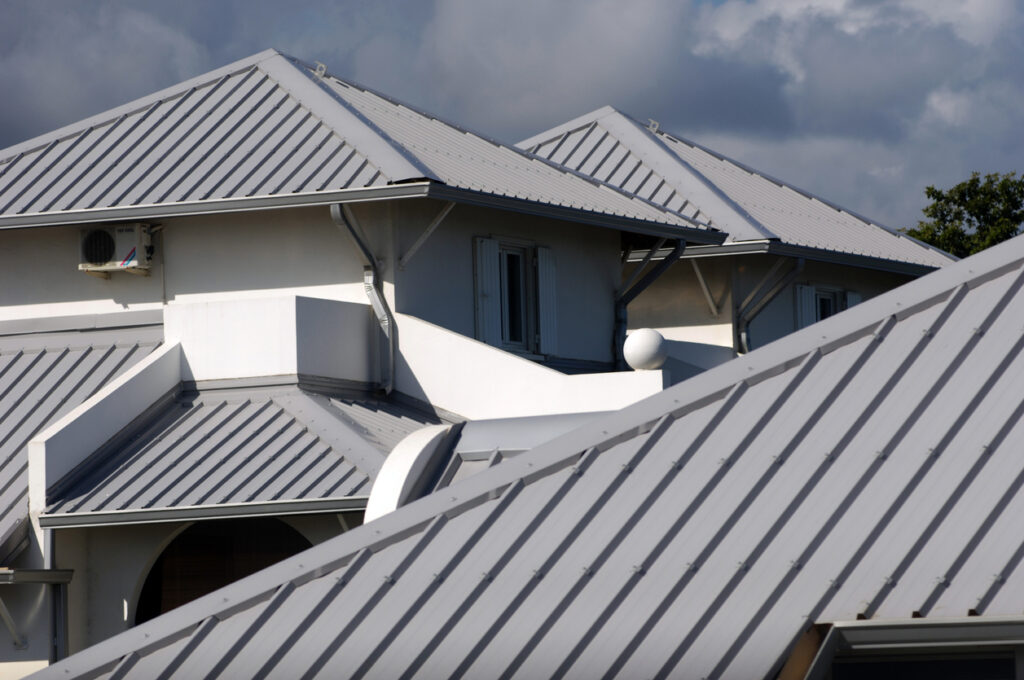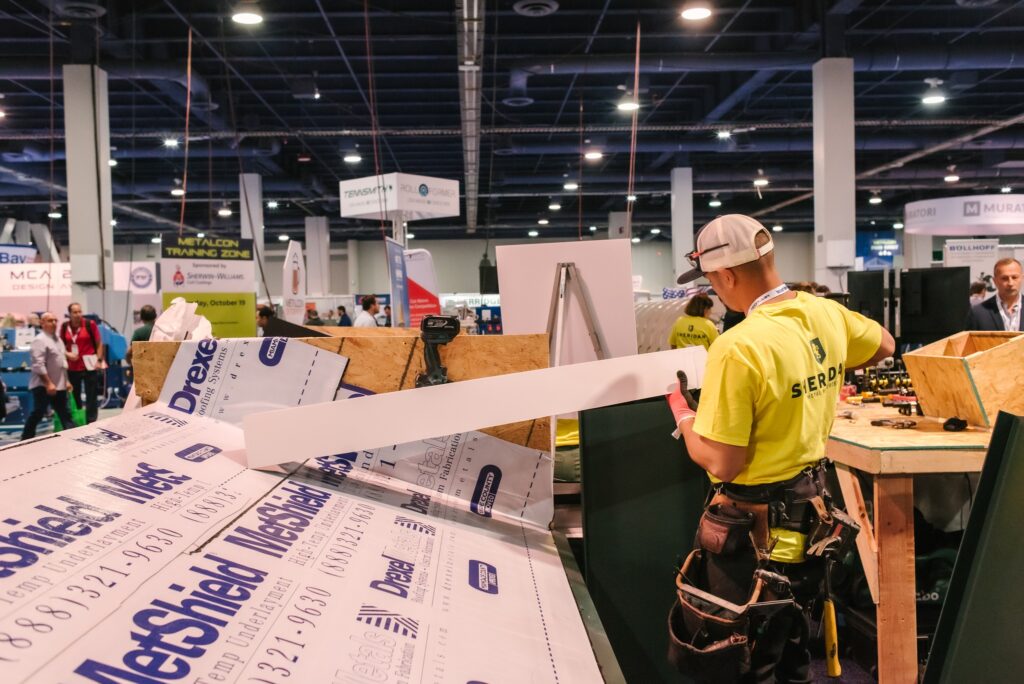
The roof of a building is one of the most important components of its architecture, serving many purposes, from protecting the interior from external elements to defining the aesthetic and structural integrity of a structure. Installing a metal roof is a smart investment for any property owner. Known for their durability, efficiency, and aesthetic appeal, metal roofs can provide decades of reliable service.
Achieving a successful installation requires careful planning and execution. Metal roofing installations can vary greatly depending on the type of existing roof, whether you’re working with exposed or hidden fasteners, and the desired style of the new roof. Here are some essential pro tips to ensure your metal roof installation project goes smoothly and delivers excellent results.
Tip #1 – Choose the Right Materials
The first step to a successful metal roof installation is selecting the right materials. Consider your budget, the climate of your area, and the desired aesthetic when choosing your materials. There are several types of metal roofing, each material has its own benefits and drawbacks:
- Aluminum: Lightweight and resistant to corrosion, making it ideal for coastal areas.
- Steel: Strong and durable, often coated to prevent rust.
- Copper: Highly durable and develops a patina over time, which can be visually appealing.
- Zinc: Long-lasting and low maintenance, but more expensive.
Tip #2 – Proper Measurements and Planning
Always Start Square. When installing a metal roofing panel, it is important to start square — meaning your vertical lines are all squarely aligned with the eave. This is a crucial step because if the first panel is even slightly tilted, the rest of the panels will all be tilted as well.
Accurate measurements are crucial for a successful installation. Begin by measuring the dimensions of your roof, including the length, width, and slope. Calculate the total square footage and add an extra 10% to account for waste and overlaps. Create a detailed plan that includes the layout of the metal panels, the placement of screws, and the location of flashing and trim. This will help you visualize the project and ensure you have all the necessary materials.
Tip #3 – Install a Moisture Barrier

Installing a moisture barrier is essential to protect your home from leaks and moisture damage. Use a high-quality underlayment, such as synthetic underlayment or roofing felt, to cover the entire roof deck. This layer acts as an additional line of defense against water infiltration.
Tip #4 – Use the Right Fasteners and Clips

Using the correct fasteners and clips is critical for the longevity and performance of your metal roof. Opt for corrosion-resistant screws with rubber washers, designed specifically for metal roofing applications. These screws should be long enough to penetrate the panels and securely anchor into the roof deck without causing damage or dimpling the metal surface.
Always place screws in the flat areas of the panels, not the raised ribs, to prevent water pooling around the fasteners—a major cause of leaks. Drive screws straight in, and avoid overtightening, which can crush the washer or distort the panel. Test your drill tension first on a scrap piece or an inconspicuous area, like where a ridge cap or flashing will cover.
In addition to fasteners, using the right clips is essential, especially for standing seam metal roofs. Clips allow panels to expand and contract with temperature changes, preventing warping, oil canning, and premature failure. Be sure to match the clips to your specific panel profile and material type for the best results.
Tip #5 — Safety First

Safety should be the top priority during any roofing project. Use proper safety equipment, such as harnesses, safety glasses, and non-slip footwear. Be mindful of weather conditions, and avoid working on the roof during rain or high winds. Wearing protective rubber-coated gloves when installing metal roofs will not only protect you from sharp edges but will also give you a good grip on the materials.
Tip #6 — Inspect and Maintain
Once your metal roof is installed, perform regular inspections and maintenance to keep it in top condition. Check for loose or missing fasteners, inspect the flashing for signs of wear, and clean any debris from the roof surface. While it may seem trivial, these tiny pieces of metal can result in unsightly rust spots where they rest on the roof. Address any issues promptly to prevent more significant problems down the line.
Tip #7 – Attend Metal Roof Installation Training at METALCON
No matter your experience level, hands-on education is one of the fastest ways to sharpen your skills, expand your knowledge, and stay ahead in the metal roofing industry. METALCON offers a range of in-depth training opportunities—right on the show floor—where you can learn from leading experts, gain practical experience, and even earn valuable certifications.
Here’s a look at some of the top workshops and learning zones you won’t want to miss:
Metal Roof Installation Training
Certified by the Metal Construction Association (MCA)
One of METALCON’s most popular workshops, this two-day, eight-hour course has certified hundreds of industry professionals. Designed and led by top roofing experts, it provides a strong foundation for those entering or advancing in the metal construction field.
Based on MCA’s Metal Roof Installation Manual, the program covers essential topics including substrates, safety, sealants, flashings, panel types and connections, tools, fasteners, maintenance, and more. After classroom training, participants head to the METALCON exhibit floor to see products in action, apply their new skills, and network with industry leaders.
Ideal for beginners, this course offers valuable hands-on experience. Upon successful completion, participants earn MCA’s Metal Roofing Certificate of Completion.
Metal Roofing from A (Aluminum) to Z (Zinc)

Presented by Rob Haddock, CEO and Founder, S-5! | Metal Construction Hall of Fame Inductee
Often referred to as “Metal Roofing 101,” this fast-paced, information-packed course is designed for contractors, sales professionals, architects, specifiers, and anyone looking to build—or refresh—their understanding of metal roofing, regardless of experience level.
Led by industry icon Rob Haddock, this comprehensive session delivers technical knowledge in a clear, common-sense format, making the art and science of metal roofing both understandable and actionable. Participants will explore:
- The history and evolution of metal roofing
- Materials, metallurgy, and corrosion behavior
- Metallic and paint coating properties
- Manufacturing and fabrication techniques
- System selection for steep and low-slope applications
- Design considerations and best practices
- Thermal cycling, panel anchorage, and installation techniques
- Seam and joint types, and proper use (and misuse) of sealants
- Troubleshooting, maintenance, and practical “do’s and don’ts”
- Wind resistance factors and how to avoid oil canning
Whether you’re involved in new construction, maintenance, or re-roofing projects, this course equips you with the critical theoretical knowledge and real-world insights needed to excel in metal roofing.
Low Slope Detailing Workshop & Certificate Course
Led by Alex Prothmann, Architectural Sheet Metal Trainer, ASM 101
This in-depth workshop offers a hands-on introduction to low-slope roofing details and will transform how you view the possibilities of sheet metal in roofing applications. Guided by sheet metal expert Alex Prothmann, participants will explore the unique challenges and creative solutions required for both low-slope and steep-slope roofs.
Through detailed instruction, you’ll dive into the core differences between the two roof types, from installation techniques and best practices to specialized tools and critical safety considerations. While the primary focus is on low-slope metal roofing, the session will also touch on steep-slope applications to highlight key distinctions. By the end of the workshop, you’ll gain a solid understanding of which techniques best fit each roof style—and how to apply them with precision and confidence.
METALCON Training Zone

This hands-on training area will feature demonstrations and education using a variety of mock-ups and materials including painted steel, aluminum, zinc, copper and other exotic materials. Training will focus on proper detailing and utilization of the right tools to enhance the skills of contractors, remodelers and others, enabling them to deliver their best, most efficient and cleanest work when installing various metal roof offerings and systems.
Led by John Sheridan of Sheridan Metal Resources and his team of experts, demonstrations will be offered in English and Spanish and tools will be available for audience testing and purchase.
MCA’s Metal Mastery Demo and Education Area

As metal continues to grow in popularity and market share, contractors and installers must master the nuances of panel forming and metal roofing system installation. A deep understanding of proper techniques leads to greater jobsite efficiency, better system performance, and higher building owner satisfaction.
At the Metal Mastery Pavilion, experts present a series of hands-on clinics covering industry best practices. Topics include the installation of metal shingles, standing seam roofing panels, retrofit systems, and demonstrations of on-site rollforming and machine maintenance. Whether you’re looking to sharpen your skills or learn new techniques, these live demonstrations will deliver actionable knowledge straight from the industry’s top professionals.
*** METALCON SUPER SAVER PRICING ***
With METALCON’s Super Saver Pricing in effect through May 8, now is the best time to register and save $75 on a Total Experience or Design District Pass. Plus, add in-depth workshops to your registration and enjoy a special discount with our Value Pass option.
